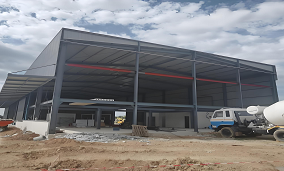Raw Materials and Finished Products Entering the Site for Steel Structure Construction

(1) Materials used in steel structure projects shall comply with the design documents and relevant current standards, possess valid quality certification documents, and shall only be used after passing inspection upon entry to the site.
(2) The inspection and acceptance of steel materials entering the site shall comply with the current national standard "Code for Acceptance of Construction Quality of Steel Structures," in addition to adhering to the "Code for Construction of Steel Structures." Full-scale sampling and retesting shall be conducted for steel materials falling under any of the following categories:
① Imported steel materials;
② Steel materials from mixed batches;
③ Thick plates with a thickness equal to or greater than 40mm and for which through-thickness (Z-direction) performance is specified in the design;
④ Steel materials used in primary load-bearing members of large-span steel structures classified as Safety Class Level I;
⑤ Steel materials for which retesting is specified in the design;
⑥ Steel materials whose quality is in doubt.
(3) For steel plates with specified through-thickness requirements:
* Z15 grade plates: Each inspection lot shall consist of plates of the same grade, same heat number, same thickness, and same delivery condition. The weight per lot shall not exceed 25 tons.
* Z25 and Z35 grade plates: Each plate shall be retested individually.
(4) The sampling, specimen preparation, and testing methods for retesting imported steel materials shall be carried out in accordance with the standards specified in the design documents and contract. Customs commodity inspection results shall be subject to approval by the supervising engineer. Once approved, they may serve as valid material retesting results.

(5) Welding materials used for critical welds, or welding materials whose quality certification documents are in doubt, shall undergo sampling retesting. For retesting, welding wire samples shall typically be taken in one test group per five batches (equivalent to heat/lot), and welding electrodes shall typically be taken in one test group per three batches (equivalent to heat/lot).
(6) When ordinary bolts are used as permanent connection bolts, and if required by the design documents or if their quality is in doubt, the minimum bolt tensile load shall be retested. Eight bolts of each specification shall be randomly selected for retesting.
(7) High-strength heavy hex bolt head fastener assemblies and high-strength twist-off bolt fastener assemblies shall respectively possess manufacturer's test reports for the torque coefficient and pre-tension (preload), which shall accompany the shipment. If high-strength bolt fastener assemblies have been stored for more than 6 months before use, the torque coefficient or pre-tension test shall be re-conducted according to relevant requirements, and they may only be used after passing the test.
(8) Torque coefficient retesting shall be performed for high-strength heavy hex bolt fastener assemblies, and pre-tension (preload) retesting shall be performed for high-strength twist-off bolt fastener assemblies. Test bolts shall be randomly selected from batches of bolts awaiting installation at the construction site. Eight sets of fastener assemblies shall be sampled per batch for retesting.



